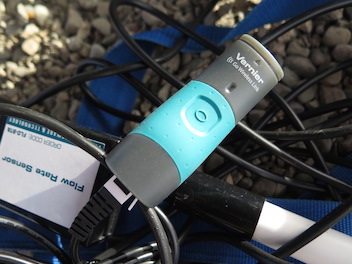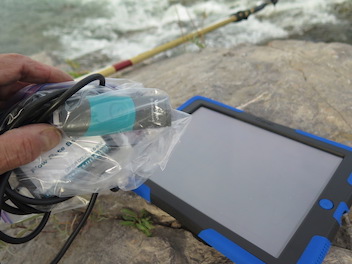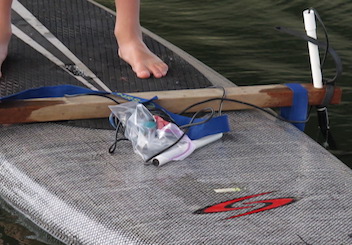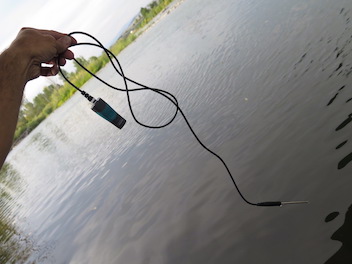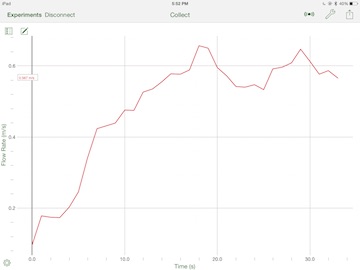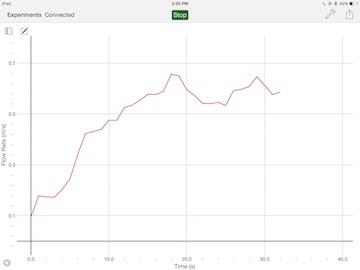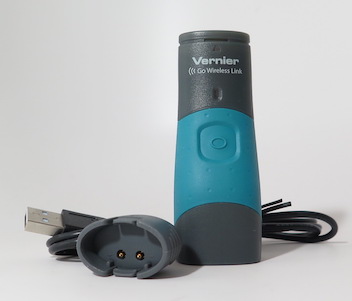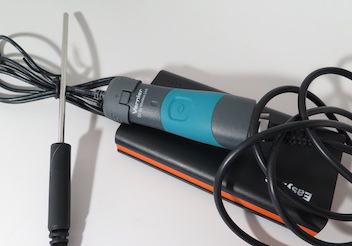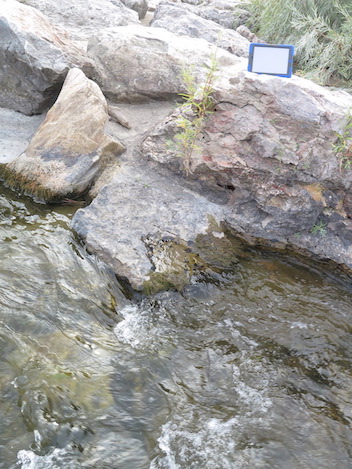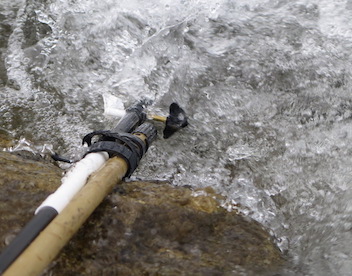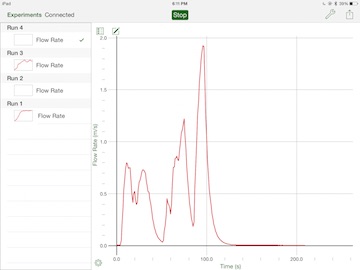The Vernier Go Wireless Link: A Bluetooth Broadcaster for your Sensors
By Martin Horejsi
Posted on 2015-09-14
Vernier’s new Go Wireless Link is a small but effective solution to expand the scope and reach of over 40 sensors. Using a Bluetooth bridge between sensor and computer or tablet, and a usable range extending up to 30 meters, the Go Wireless Link provides an upgrade to existing sensors and a new frontier in what’s possible in data collection. For example, the increased distance between the sensor and student is helpful for many reasons including experimental opportunity, safety, and when measuring physical parameters inside a sealed container.
en the popularity of river surfing with high school students, and that another set of waves is planned in the river.
Tweet All About It: Happening Now @NSTA
By Lauren Jonas, NSTA Assistant Executive Director
Posted on 2015-09-12
It’s been a busy week in the Twitterverse for the National Science Teachers Association (NSTA). Our favorite shout-out came from Science Friday, promoting great science books for kids; we were delighted to see one of our readers’ favorites on the list: Next Time You See the Moon!
Try reading some of these great science books to your kids tonight! http://t.co/MtKsl5HNOC pic.twitter.com/TsLCnpLiSE
— Science Friday (@scifri) September 12, 2015
Science teachers have an opportunity now to nominate themselves or a colleague for a prestigious position on our Board and Council, and if you missed the webinar mentioned in this tweet, never fear, it’s archived at the same link. Take a look, and consider one of the positions available!
Listening to a webinar on preparing an application for #NSTA Board & Council #PD #scichat http://t.co/uzb7bYI1Cm
— Celeste Payne (@cmpayne87) September 8, 2015
Some of you shared your back to school stories. What can we say, @chemteacher93, @TannaNicely, and @ms_calaniz? STEM and the NGSS are hot!
Nothing like a 90 degree classroom to do our first lab of the year!#STEMeducation #NSTA pic.twitter.com/ItPd8oO4hC
— Aimee Selby (@chemteach93) September 8, 2015
Think like a scientist! @southknoxelem learning about @STEM_Outreach thru stemscouts! @BeckyAshe @knoxschools @NSTA pic.twitter.com/f2LxWkh0dD
— Tanna Nicely (@TannaNicely) September 11, 2015
“Hot Air Balloon” Challenge #NGSS @EarlyImplement 2nd grade #science pic.twitter.com/lG2H1FTwOT
— Christina Alaniz (@ms_calaniz) September 12, 2015
#HASTA gave a warm welcome to our President, Carolyn Hayes, showing her how they nurture the next generation of scientists in their lovely state!
@NSTA president @caahayes observes #plankton with @kahikai @josephwilsonca on Hikianalia! @HokuleaWWV pic.twitter.com/gH6AUgKfgN
— Lauren Kaupp (@mySciHI) September 11, 2015
Carolyn Hayes, President of @NSTA at #hasta addresses the audience, presents teacher awards #stem @PunahouSchool pic.twitter.com/m0hC6H4Mu5
— Joseph Wilson (@josephwilsonca) September 12, 2015
ICYMI, we are indeed giving away free enhanced e-books to anyone who joins or renews their regular membership, through September 30, 2015.
#Teachers, join @NSTA or renew your membership by Sept. 30, and you’ll get a free e-book. Learn more about NSTA: http://t.co/ug05p4b7uz
— CityScience (@CityScienceOrg) September 10, 2015
Planning to go to our Philly conference, November 12-14? Take advice from @JarettKuhns and visit the Franklin Institute—all attendees get free admission!
In November I’m attending the NSTA conference in Philadelphia and visiting the Franklin Institute to explore the human brain #NSTA15 #stoked
— Jarett Kuhns (@JarettKuhns) September 12, 2015
And what better way to close out the list than with another book list, from District Administration, mentioning another of our readers’ favorites, NGSS for All Students?
#education news, via @DA_magazine | Ken Robinson’s “Creative Schools” tops reading list for education leaders http://t.co/UJWYyuLCR9 #NSTA
— NatSciTeachAssoc (@NSTA) September 11, 2015
The mission of NSTA is to promote excellence and innovation in science teaching and learning for all.
2015 Area Conferences
2016 National Conference
2016 STEM Forum & Expo
Follow NSTA
It’s been a busy week in the Twitterverse for the National Science Teachers Association (NSTA). Our favorite shout-out came from Science Friday, promoting great science books for kids; we were delighted to see one of our readers’ favorites on the list: Next Time You See the Moon!
Electric and Magnetic Forces
Making Science Accessible in Multilingual Classrooms
By Peggy Ashbrook
Posted on 2015-09-10
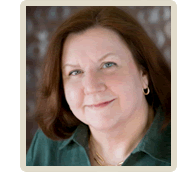 Please welcome guest blogger Karen N. Nemeth, writing about making science learning accessible in multilingual classrooms. Karen N. Nemeth, Ed.M. is an author, consultant and presenter focusing on improving early childhood education for children who are dual language learners. She is a writer and consulting editor for NAEYC and holds leadership positions at NABE and TESOL. She has published many books and articles for early childhood educators and she provides resources for supporting diverse young learners and their families at: www.languagecastle.com
Please welcome guest blogger Karen N. Nemeth, writing about making science learning accessible in multilingual classrooms. Karen N. Nemeth, Ed.M. is an author, consultant and presenter focusing on improving early childhood education for children who are dual language learners. She is a writer and consulting editor for NAEYC and holds leadership positions at NABE and TESOL. She has published many books and articles for early childhood educators and she provides resources for supporting diverse young learners and their families at: www.languagecastle.com
Science learning provides so many opportunities for hands-on exploration, discovery and discussion in early childhood. But, how can teachers make science learning meaningful for children who don’t speak the same language? The key to succeeding with dual language learners is to plan science activities with five key questions in mind:
- Will the materials and experiences in this activity make sense to a child who doesn’t understand what I say?
- Will this activity teach knowledge and/or skills that the child will have many opportunities to use in every day life?
- Will this activity focus on the here and now to support beginning science learning?
- What words do you know in the child’s home language that you can use to help him or her connect to the vocabulary of the planned activity?
- What resources can you use to help the child understand the words, concepts and connections you want him or her to make in this activity?
These questions will help you in two ways. First, they will help you to make adaptations to the activities you plan to introduce so that the learning is accessible to all of the children. Second, they will guide you in deciding when some activities are just not going to work with a group of children who speak different languages.
Miss Janet saw a fun science idea on a teacher website. She thought about buying the bars of white soap and putting them in the microwave to watch them expand. The video on the website was pretty amazing. But, as Miss Janet starting adding the activity to her lesson plan format, she realized it didn’t really make a good connection for her students who are DLLs. She could use her words to explain what she was doing, but just watching a bar of soap expand in a microwave didn’t have any real meaning that a child could use and it was certainly not self-explanatory for DLLs. So, she moved on to an activity that she knew would benefit all of her students.
There are plenty of options for science explorations, so letting go of some just makes room for you to try others. Try these tips from a recent post on www.languagecastle.com
 Focus on activities that are linked to real life experiences that children can recognize and connect with their prior knowledge. Look for materials that children already understand so they don’t depend on explanations. Ex: Explore how food grows, where it grows, which animals eat what, and how we use science to prepare foods. Planting seeds is a wonderful science activity, but may be best left until a bit later in the school year when DLLs have more experience with the nature of science and the practices of science. When they are just getting started in school and learning a new language, activities that show no immediate results may be hard for them to understand. After they have adjusted to classroom practices and routines and they have begun to learn more science vocabulary in their home language and in English, long-term projects will be more effective.
Focus on activities that are linked to real life experiences that children can recognize and connect with their prior knowledge. Look for materials that children already understand so they don’t depend on explanations. Ex: Explore how food grows, where it grows, which animals eat what, and how we use science to prepare foods. Planting seeds is a wonderful science activity, but may be best left until a bit later in the school year when DLLs have more experience with the nature of science and the practices of science. When they are just getting started in school and learning a new language, activities that show no immediate results may be hard for them to understand. After they have adjusted to classroom practices and routines and they have begun to learn more science vocabulary in their home language and in English, long-term projects will be more effective.
- Learn key vocabulary in the children’s home languages so you can explicitly connect the new words to words they already understand. Home language vocabulary is connected to a collection of concepts, so linking home language to new has lots of learning benefits. Ex. “This is a little frog. In Spanish we say la ranita. La ranita is a little frog – let’s all jump like a frog together.” This is more than translation – it helps the child take everything he knows about frogs and transfer it to his new language. Research shows that concepts learned in the home language transfer readily to the new language and form a solid foundation for future learning.
 Assign science buddies (peers or adult volunteers) to work together so children can have interesting conversations about their discoveries, even if you don’t understand what they say. Be sure to record the interactions so someone can help you translate and assess the level of each child’s learning.
Assign science buddies (peers or adult volunteers) to work together so children can have interesting conversations about their discoveries, even if you don’t understand what they say. Be sure to record the interactions so someone can help you translate and assess the level of each child’s learning.
- Use digital resources to support topics you want to explain or discuss. Choose topics that you can find on Youtube.com, Teachertube.org, or National Geographic’s website, for example, so children can see the process that you are trying to explain.
- Learn a few key questions in the languages of the children so you can guide their thinking and let them continue independently. Ex. What do you think will happen next? How does this feel or smell? Encourage children to answer in any language – or even with drawings – to express their knowledge.
Now – dig in and have fun with science learning that works for DLLs!
Miss Janet went through a list of science activities. She crossed out “outer space” and “dinosaurs” because they can’t be represented in the here and now or in a child’s every day life. Instead, she came up with her own activities that involved cleaning things up in the classroom. She brought in different materials and explored with the children what happened when they blotted spilled water with paper towel, a sponge, a brush and dustpan, a plastic bag, a spray bottle of water or some aluminum foil. Then she presented other potential messes like spilled sand, a pile of crayons, and some beads. Using photos, Miss Janet encouraged the children to work in pairs to chart which materials were most effective for each kind of mess. She modeled for the children how they could draw what they observed or take pictures with their iPads. Some children focused on trying the same thing repeatedly. Others tried a few things and talked all about them together. And a few others focused intently on testing each combination and recording what they learned. The activity was meaningful and informative for all of the children and allowed each of them to learn about the physical world and about making observations even if they didn’t yet speak English!
 Please welcome guest blogger Karen N. Nemeth, writing about making science learning accessible in multilingual classrooms. Karen N. Nemeth, Ed.M. is an author, consultant and presenter focusing on improving early childhood education for children who are dual language learners. She is a writer and consulting editor for NAEYC and holds leadership positions at NABE and TESOL.
Please welcome guest blogger Karen N. Nemeth, writing about making science learning accessible in multilingual classrooms. Karen N. Nemeth, Ed.M. is an author, consultant and presenter focusing on improving early childhood education for children who are dual language learners. She is a writer and consulting editor for NAEYC and holds leadership positions at NABE and TESOL.
Nurture a love of learning in your science classroom
By Claire Reinburg
Posted on 2015-09-10
How can we cultivate a student’s (and a teacher’s!) natural love of learning and exploration amid so many demands in today’s schools? The recent article “When Success Leads to Failure” in The Atlantic by teacher–author Jessica Lahey drew our attention once again to the pressure students feel to test well and excel in their studies—perhaps at the expense of their love of learning. When facing numerous expectations, teachers and students constantly wonder, “Do we have time to follow our curiosity and explore that exciting question or problem raised during today’s lab? Or is it time to turn toward the next textbook chapter, college-application essay, or high-stakes exam?” For this month’s issue of Book Beat, we selected these lessons and activities that can help you nurture students’ love of science exploration and keep the light of curiosity shining brightly in your classroom.
When in Science Class, Do as Scientists Do
The beginning of the school year is the perfect time to introduce students to the many ways that scientists do their  work, including making observations, using models, and conducting experiments. Consider using Page Keeley’s formative assessment probe “‘Doing’ Science” from What Are They Thinking? Promoting Elementary Learning Through Formative Assessment to uncover what your K–5 students think about how we study science and the practices of scientists. With the insights you glean, you’ll have all you need to design classroom experiences that will help students see the numerous scientific methods we employ when exploring the natural world. Encourage your students in grades 8–12 to look for patterns, a key strategy scientists use to try to make sense of the bewildering array of natural phenomena we encounter daily.
work, including making observations, using models, and conducting experiments. Consider using Page Keeley’s formative assessment probe “‘Doing’ Science” from What Are They Thinking? Promoting Elementary Learning Through Formative Assessment to uncover what your K–5 students think about how we study science and the practices of scientists. With the insights you glean, you’ll have all you need to design classroom experiences that will help students see the numerous scientific methods we employ when exploring the natural world. Encourage your students in grades 8–12 to look for patterns, a key strategy scientists use to try to make sense of the bewildering array of natural phenomena we encounter daily.  The chapter “Science Without Numbers: Searching for Patterns” from John Haysom’s Science Fair Warm-Up, Grades 8–12: Learning the Practice of Scientists gives students opportunities to study data sets in search of underlying patterns, which can lead to deeper understanding of natural phenomena. (See also the books in the Science Fair Warm-Up series for grades 5–8 and 7–10 .)
The chapter “Science Without Numbers: Searching for Patterns” from John Haysom’s Science Fair Warm-Up, Grades 8–12: Learning the Practice of Scientists gives students opportunities to study data sets in search of underlying patterns, which can lead to deeper understanding of natural phenomena. (See also the books in the Science Fair Warm-Up series for grades 5–8 and 7–10 .)  For high school students, you can also download the lab “Environmental Influences on Animal Behavior: How Has Climate Change Affected Bird Migration?” from Victor Sampson and coauthors’ Argument-Driven Inquiry in Biology: Lab Investigations for Grades 9–12 to guide students in exploring animal behavior and the interactions among species and their environment. While engaged in this lab, students will learn about the differences between data and evidence and gain experience using an online database.
For high school students, you can also download the lab “Environmental Influences on Animal Behavior: How Has Climate Change Affected Bird Migration?” from Victor Sampson and coauthors’ Argument-Driven Inquiry in Biology: Lab Investigations for Grades 9–12 to guide students in exploring animal behavior and the interactions among species and their environment. While engaged in this lab, students will learn about the differences between data and evidence and gain experience using an online database.
Foster a Culture of Curiosity
 We know students are engaged when they ask “What is that?” and “What’s happening here?” at the sight of a puzzling object or phenomenon. Curiosity and questions drive scientific exploration. An important part of the scientist’s work is making observations and inferences when facing new phenomena, and having students explore these concepts early in the school year builds a foundation for their scientific studies. For elementary students, download the lesson “Earth Hounds” from Karen Ansberry and Emily Morgan’s Picture-Perfect Science Lessons, Expanded 2nd Edition: Using Children’s Books to Guide Inquiry, 3–6. This lesson begins with reading the entertaining book Dr. Xargle’s Book of Earth Hounds, in which an alien professor draws hilarious conclusions from his observations of dogs. Students then make observations and inferences about the unseen properties of mystery objects, all while learning the differences between observations and inferences and how scientists generate knowledge using both. For K–8 students, download
We know students are engaged when they ask “What is that?” and “What’s happening here?” at the sight of a puzzling object or phenomenon. Curiosity and questions drive scientific exploration. An important part of the scientist’s work is making observations and inferences when facing new phenomena, and having students explore these concepts early in the school year builds a foundation for their scientific studies. For elementary students, download the lesson “Earth Hounds” from Karen Ansberry and Emily Morgan’s Picture-Perfect Science Lessons, Expanded 2nd Edition: Using Children’s Books to Guide Inquiry, 3–6. This lesson begins with reading the entertaining book Dr. Xargle’s Book of Earth Hounds, in which an alien professor draws hilarious conclusions from his observations of dogs. Students then make observations and inferences about the unseen properties of mystery objects, all while learning the differences between observations and inferences and how scientists generate knowledge using both. For K–8 students, download  “The Little Tent That Cried,” a chapter from Richard Konicek-Moran’s Everyday Earth and Space Science Mysteries that can be an excellent introduction to the water cycle. Students engage with the story of two young campers who awake to water dripping on them inside their tent. Just as the children in the story puzzle over where the water is coming from, your students will ponder the source of the dripping water while learning more about condensation and evaporation in the context of a natural situation. Explore other topics covered by the many stories in the Everyday Science Mysteries series.
“The Little Tent That Cried,” a chapter from Richard Konicek-Moran’s Everyday Earth and Space Science Mysteries that can be an excellent introduction to the water cycle. Students engage with the story of two young campers who awake to water dripping on them inside their tent. Just as the children in the story puzzle over where the water is coming from, your students will ponder the source of the dripping water while learning more about condensation and evaporation in the context of a natural situation. Explore other topics covered by the many stories in the Everyday Science Mysteries series.
How can we cultivate a student’s (and a teacher’s!) natural love of learning and exploration amid so many demands in today’s schools? The recent article “When Success Leads to Failure” in The Atlantic by teacher–author Jessica Lahey drew our attention once again to the pressure students feel to test well and excel in their studies—perhaps at the expense of their love of learning.
Informal professional development
By Mary Bigelow
Posted on 2015-09-10
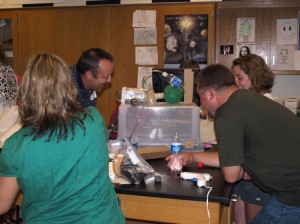 I teach in a private school that does not offer much in terms of professional development (PD), especially for science teachers. My colleagues and I would like to visit some science museums and centers. Would that count as PD? Do you have any other suggestions for us? —M., Maryland
I teach in a private school that does not offer much in terms of professional development (PD), especially for science teachers. My colleagues and I would like to visit some science museums and centers. Would that count as PD? Do you have any other suggestions for us? —M., Maryland
To a science teacher, an ideal day away from school might include a stroll through a zoo or botanical garden, an afternoon in a cool planetarium or aquarium, a visit to a science center or natural history museum, or a hike through the woods or on a beach with a camera, a pair of binoculars, and a guidebook. On these personal field trips, we don’t need to worry about permission slips and bus counts – we can follow our interests and learn on our own terms.
It’s enjoyable to visit one of these places with another science teacher. The level of conversation is different than when you visit these places alone, with students, or with your families. A day exploring one of these venues and discussing science topics is a great way to increase content knowledge and examine different ways of learning.
For example, one day at the American Museum of Natural History in New York, my colleague and I spent a lot of time with the exhibits related to plate tectonics. We learned new content information, and the displays gave us some ideas for sharing this information with our students. We took lots of notes and made lots of sketches. (Our spouses, who are not science teachers, eventually wandered off to other exhibits!)
My school district allowed my colleague and me to count the time we spent in the museum as PD hours. We submitted a report describing where we went, what we did, what we learned, and how that learning will apply to the classroom. You could ask your school administrator if such a procedure would be acceptable in your situation.
With all that we can learn both onsite and online (through websites, e-mail lists, and social media), perhaps this informal, individualized PD should become a viable part of our ongoing professional education. Unlike more formal, school-wide PD events, we set the goals and personalize the experience to our own needs. This process keeps us informed and up-to-date, building on our previous knowledge and inspiring us to continue to learn new things. (I’m sure that my childhood visits to the Franklin Institute in Philadelphia had a profound influence on my own interest in science.)
NSTA’s position statement on informal science education recognizes the contributions of informal science institutions and organizations in providing opportunities for lifelong learning—and not just for students but for teachers, too.
You can also visit science museums and centers through the eyes of your students. What strategies do the informal educators use to attract our attention and hold our interest in the exhibits? In The Science Teacher, “Learning Science Beyond the Classroom” describes some of these techniques. Could any of these apply to the classroom?
As the price of travel increases, don’t forget to visit places close to home. To find a new place to visit, check out the website of the Association of Zoos and Aquariums or the American Alliance of Museums. If you’re a member of an organization, check for reciprocal admissions. Many of these organizations offer lectures, field trips, hands-on workshops, graduate study, meet-a-scientist, and other special events that could become part of an individualized or informal PD plan.
Many of these informal science venues have excellent websites, too. I can spend hours on the website of the Exploratorium in San Francisco with its comprehensive collection of lessons and demonstrations for the classroom. These institutions may also have virtual tours, too. The National Park Service website has armchair views of the parks – not quite the same as being there, but still a good experience.
Adding informal, teacher-selected opportunities to a school’s PD plan is a win-win option. Teachers (or groups of teachers) can design opportunities based on their individual subject area needs and the school can spend its ever-decreasing PD funds on school-wide topics.
More PD suggestions:
NSTA’s K-College September 2015 Science Education Journals Online
By Korei Martin
Posted on 2015-09-07
Wondering how to introduce your students to engineering? Want an in-depth look at Pluto? Want to know when the “Great Acceleration” began and why it’s named that? The September K–College journals from the National Science Teachers Association (NSTA) have the answers you need. Written by science teachers for science teachers, these peer-reviewed journals are targeted to your teaching level and are packed with lesson plans, expert advice, and ideas for using whatever time/space you have available. Browse the September issues; they are online (see below), in members’ mailboxes, and ready to inspire teachers!
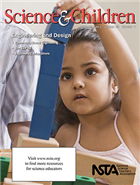 Science and Children
Science and Children
The Next Generation Science Standards (NGSS) is leading the call for more emphasis on engineering in our schools. This issue of S&C includes strategies, ideas, and techniques to help you bring engineering and the design process into your classroom.
Featured articles (please note, only those marked “free” are available to nonmembers without a fee):
- Free – Answers to Teachers’ Questions About the Next Generation Science Standards
- Community-Based Engineering
- Designing a Sound-Reducing Wall
- Free – Editor’s Note: STEM
- Gimme an “E”!
- Free – Scampering Into Engineering!
- The EDP-5E
- Full Table of Contents
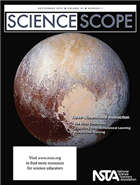 Science Scope
Science Scope
The New Horizons space mission provided us with a spectacular, in-depth look at Pluto as it hurtled by the dwarf planet in July of this year. In this issue, we explain how to take an in-depth look at a variety of science concepts by incorporating the three dimensions of the Next Generation Science Standards into your lesson plans.
Featured articles (please note, only those marked “free” are available to nonmembers without a fee):
- Free – Answers to Teachers’ Questions About the Next Generation Science Standards
- Botanical Heart Throbs: Heart Rate in Blackworms
- Free – Editor’s Roundtable: Three-Dimensional Teaching
- Exploring the Science of Less-Familiar Forms of Animal “Flight”
- Free – The Controversy Over Pluto: Planet or Astronomic Oddball?
- Using Professional Noticing to Address Middle Level Students’ Alternative Conceptions of Lunar Phases
- Full Table of Contents
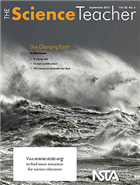 The Science Teacher
The Science Teacher
Change has always been a constant on planet Earth, yet change today seems different both in pace (fast) and source (us). The middle of the 20th century began what has been dubbed a “Great Acceleration,” a rapid and profound transformation of humanity’s relationship with the natural world, a relationship addressed in several feature articles in this issue. This accelerated change has led scientists to consider whether to christen a new geological epoch, the Anthropocene, to recognize the human species as a biogeophysical force capable of leaving a durable imprint on the geological record. The Earth’s intricate interrelated systems deserve our mindful attention and protection. If this is truly the age of the Anthropocene, will we be up to the task?
Featured articles (please note, only those marked “free” are available to nonmembers without a fee):
- Free – A Rising Tide
- Free – Answers to Teachers’ Questions About the Next Generation Science Standards
- Free – Editor’s Corner: Our Changing Earth
- Ocean Acidification
- Teaching Science Through Inquiry
- The E-mail Lab
- The Resource Beneath Our Feet
- Full Table of Contents
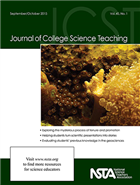 Journal of College Science Teacher
Journal of College Science Teacher
Learn how one author increased student confidence in giving scientific presentations by showing them how to present findings as a narrative story or personal anecdote. Don’t miss the study that assessed the effect of a problem-based learning teaching strategy on student academic achievement in an undergraduate Biomechanics course. Also, read how participation in Saturday Science—a weekend science enrichment program where local families are invited to participate in hands-on science activities—led to increased confidence for student teachers in various aspects of science teaching and learning.
Featured articles (please note, only those marked “free” are available to nonmembers with
out a fee):
- Free – Editorial: Heavy in August
- Geographic Affiliation and Sense of Place: Influences on Incoming Online Students’ Geological and Meteorological Content Knowledge
- Free – Getting the Most Out of Dual-Listed Courses: Involving Undergraduate Students in Discussion Through Active Learning Techniques
- Interactive Taste Tests Enhance Student Learning
- Research and Teaching: Assessing the Effect of Problem-Based Learning on Undergraduate Student Learning in Biomechanics
- Research and Teaching: Data Visualization Literacy: Investigating Data Interpretation Along the Novice–Expert Continuum
- Research and Teaching: Investigating Preservice Teachers’ Self-Efficacy Through Saturday Science
- Turning Scientific Presentations Into Stories
- Using Reading Quizzes in STEM Classes—The What, Why, and How
- Full Table of Contents
Get these journals in your mailbox as well as your inbox—become an NSTA member!
The mission of NSTA is to promote excellence and innovation in science teaching and learning for all.
Follow NSTA
NSTA Needs You To Be One of Our Next Leaders
By Guest Blogger
Posted on 2015-09-07
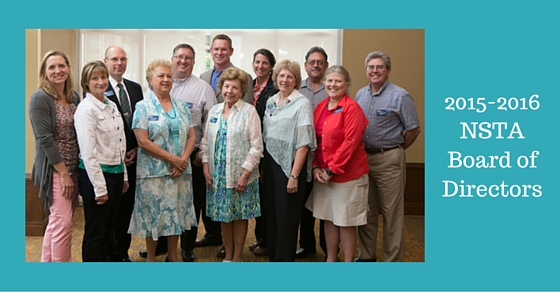
Reflecting on the Uncle Sam poster used in recruiting individuals to serve in the United States Armed Services, I’m putting out a call on behalf of the National Science Teachers Association (NSTA) Board and Council for science teachers to become the next leaders of NSTA. The NSTA Board of Directors and Council work together to promote excellence and innovation in science teaching and learning for all. There are many opportunities to serve, and you can learn more about them in a web seminar being held on September 8 (archives will be available for those who cannot attend the live seminar). Nominations are now open to apply for the following leadership roles:
- President-Elect
- Coordination & Supervision Director
- High School Level Director
- College Level Director
- District Directors in Districts III, V, IX, XI, XV, and XVII
Being a member of the NSTA leadership team enables you to be on the front line of promoting science education. We are in an exciting time of empowering our students to become the next generation of innovators and creative thinkers. As part of the leadership team, you will bring that message to our members and others that science education counts.
So don’t delay. Applications are available online, and the deadline for submitting applications is October 19, 2015.
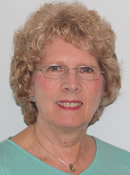 I can’t wait to see who will take the challenge of being a NSTA leader and be on the ballot for the 2016-2017 NSTA Leadership Team!
I can’t wait to see who will take the challenge of being a NSTA leader and be on the ballot for the 2016-2017 NSTA Leadership Team!
Carolyn Hayes is the NSTA President, 2015-2016; follow her on Twitter at caahayes.
The mission of NSTA is to promote excellence and innovation in science teaching and learning for all.
Follow NSTA



